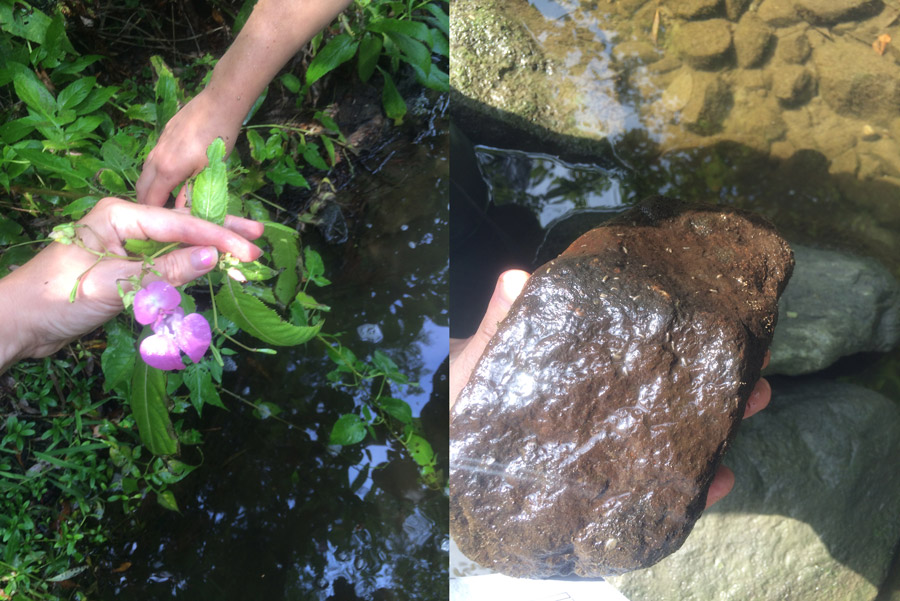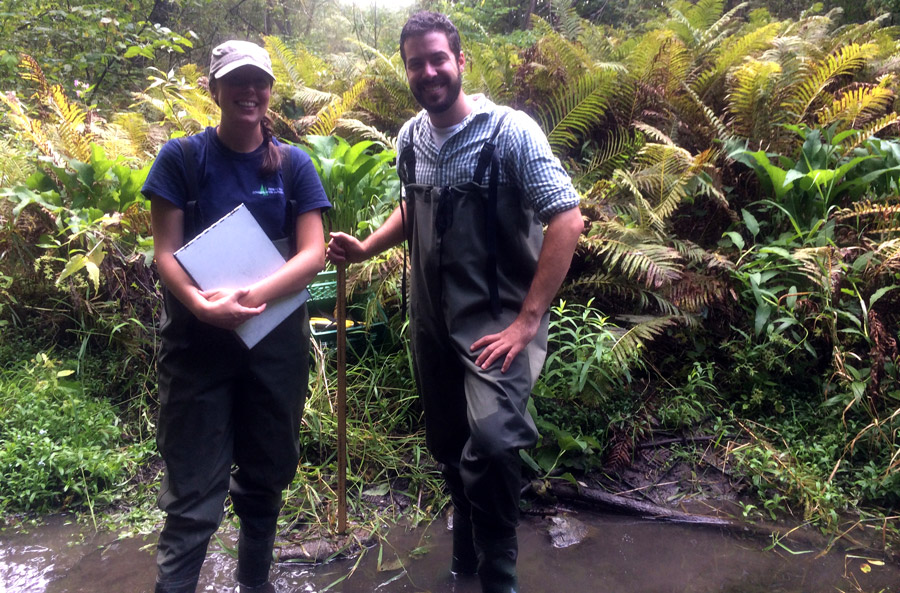Bubbling brooks and careening creeks with City Stream Watch
On August 19th I had the pleasure of meeting Chelsey and Justin from the Rideau Valley Conservation Authority who work on City Stream Watch, a program where they analyse local streams. I wanted to experience their protocol and they were kind enough to take me out and answer hundreds of questions from me!
Wading into Black Rapids Creek

After getting our waders on, we went to the creek, an beautiful undisturbed treasure. Since it’s not easily accessible it had little garbage or human influence. It was shallow with lots of rocks, some silt and gravel, and most stones were covered in green algae, fairly common for a stream like this that doesn’t receive much waterflow. Vegetation was all around it with some trees overhanging but there were not many plants in the creek itself.
Testing the waters
Their protocol is very thorough. We tested a 100m section of the water noting all aspects of the stream, including regular test parameters like pH and conductivity, plant species, bank and stream width, erosion, animal life, human intervention, waterflow and so much more! There were many pages to fill out for every 100m stretch of the stream. I got involved in measuring water depth, stream width and got to use the fancy monitoring device to check for test values.

Determining health
There are lots of factors that affect stream health, and while this stream seemed natural and undisturbed, we only saw one sole creature, the mottled sculpin, a species who was, according to Justin, actually generally considered to be a sensitive species of fish especially to temperature and oxygen levels. They need cool/cold temperatures and high oxygen so they aren’t a good indicator of sub-optimal conditions.
He also noted that some of our oxygen levels were lower than optimal for streams with lots of life (these factors are (subtly or largely) different for rivers, lakes and swamps).

Things are not always what they seem at first glance. This healthy looking stream didn’t have a thriving fish population, and I asked why. My hosts said while they couldn’t know for sure, they had some hypotheses. They suggested that it was probably a combination of factors or contaminants from agriculture, stormwater and other human factors which could cause fish to be in fewer numbers. Even with best practices, farms still get run-off that can affect small streams. It could also just be an unproductive phase of the stream’s year, so they are cautious about drawing firm conclusions. I also learned that invisible factors from industry affect our waterways: for example, if aluminium was to get into the water, many fish would die.

Thank you, City Stream Watch!
We spent some time talking about their program and I could feel how passionate they are about protecting streams. They work to remove invasive species and promote regeneration as well as gain insight on temporary streams (those that exist during the spring thaw produce very different ecosystems). Their Stream Watch program works with volunteers who learn protocols to help them get a great overview of every stream, and they return to each stream every 6 years, since it takes so long to conduct such a thorough examination. If you’re interested in volunteering with them, the stream protocol is finished for this year, but you can join me in volunteering with them on an upcoming shoreline restoration project on September 18th.
They have generously agreed to give us some of their data this fall to see how streams can be part of Water Rangers. Their program collects way more than we could possibly display, so we will only be using some of this rich data! It was so important in our planning phase to see how they work and listen to their concerns for a less managed Citizen Science program that we’re working on with our app.

Thank you again to City Stream Watch! It’s so amazing to see such a great program in our city.
